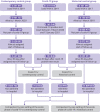Risks of mental health outcomes in people with covid-19: cohort study
- PMID: 35172971
- PMCID: PMC8847881
- DOI: 10.1136/bmj-2021-068993
Risks of mental health outcomes in people with covid-19: cohort study
Abstract
Objective: To estimate the risks of incident mental health disorders in survivors of the acute phase of covid-19.
Design: Cohort study.
Setting: US Department of Veterans Affairs.
Participants: Cohort comprising 153 848 people who survived the first 30 days of SARS-CoV-2 infection, and two control groups: a contemporary group (n=5 637 840) with no evidence of SARS-CoV-2, and a historical control group (n=5 859 251) that predated the covid-19 pandemic.
Main outcomes measures: Risks of prespecified incident mental health outcomes, calculated as hazard ratio and absolute risk difference per 1000 people at one year, with corresponding 95% confidence intervals. Predefined covariates and algorithmically selected high dimensional covariates were used to balance the covid-19 and control groups through inverse weighting.
Results: The covid-19 group showed an increased risk of incident anxiety disorders (hazard ratio 1.35 (95% confidence interval 1.30 to 1.39); risk difference 11.06 (95% confidence interval 9.64 to 12.53) per 1000 people at one year), depressive disorders (1.39 (1.34 to 1.43); 15.12 (13.38 to 16.91) per 1000 people at one year), stress and adjustment disorders (1.38 (1.34 to 1.43); 13.29 (11.71 to 14.92) per 1000 people at one year), and use of antidepressants (1.55 (1.50 to 1.60); 21.59 (19.63 to 23.60) per 1000 people at one year) and benzodiazepines (1.65 (1.58 to 1.72); 10.46 (9.37 to 11.61) per 1000 people at one year). The risk of incident opioid prescriptions also increased (1.76 (1.71 to 1.81); 35.90 (33.61 to 38.25) per 1000 people at one year), opioid use disorders (1.34 (1.21 to 1.48); 0.96 (0.59 to 1.37) per 1000 people at one year), and other (non-opioid) substance use disorders (1.20 (1.15 to 1.26); 4.34 (3.22 to 5.51) per 1000 people at one year). The covid-19 group also showed an increased risk of incident neurocognitive decline (1.80 (1.72 to 1.89); 10.75 (9.65 to 11.91) per 1000 people at one year) and sleep disorders (1.41 (1.38 to 1.45); 23.80 (21.65 to 26.00) per 1000 people at one year). The risk of any incident mental health diagnosis or prescription was increased (1.60 (1.55 to 1.66); 64.38 (58.90 to 70.01) per 1000 people at one year). The risks of examined outcomes were increased even among people who were not admitted to hospital and were highest among those who were admitted to hospital during the acute phase of covid-19. Results were consistent with those in the historical control group. The risk of incident mental health disorders was consistently higher in the covid-19 group in comparisons of people with covid-19 not admitted to hospital versus those not admitted to hospital for seasonal influenza, admitted to hospital with covid-19 versus admitted to hospital with seasonal influenza, and admitted to hospital with covid-19 versus admitted to hospital for any other cause.
Conclusions: The findings suggest that people who survive the acute phase of covid-19 are at increased risk of an array of incident mental health disorders. Tackling mental health disorders among survivors of covid-19 should be a priority.
© Author(s) (or their employer(s)) 2019. Re-use permitted under CC BY-NC. No commercial re-use. See rights and permissions. Published by BMJ.
Conflict of interest statement
Competing interests: Competing interests: All authors have completed the ICMJE uniform disclosure form at www.icmje.org/coi_disclosure.pdf and declare support from the US Department of Veterans Affairs and the American Society of Nephrology for the submitted work. ZAA reports receiving consultation fees from Gilead Sciences and receipt of funding (unrelated to this work) from Tonix pharmaceuticals.
Figures








Comment in
-
Mental health in people with covid-19.BMJ. 2022 Feb 16;376:o415. doi: 10.1136/bmj.o415. BMJ. 2022. PMID: 35172969 No abstract available.
-
Mental health after covid-19.BMJ. 2022 Feb 16;376:o326. doi: 10.1136/bmj.o326. BMJ. 2022. PMID: 35172977 No abstract available.
-
Patients surviving COVID-19 had increased risk for adverse mental health outcomes vs. persons without COVID-19.Ann Intern Med. 2022 Jun;175(6):JC69. doi: 10.7326/J22-0031. Epub 2022 Jun 7. Ann Intern Med. 2022. PMID: 35667077
References
MeSH terms
LinkOut - more resources
Full Text Sources
Medical
Miscellaneous
